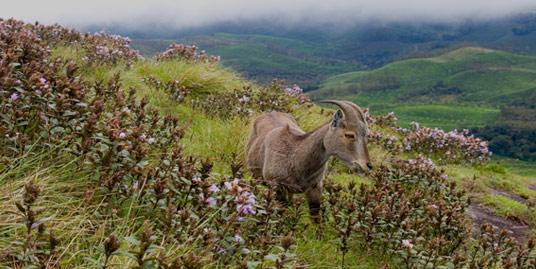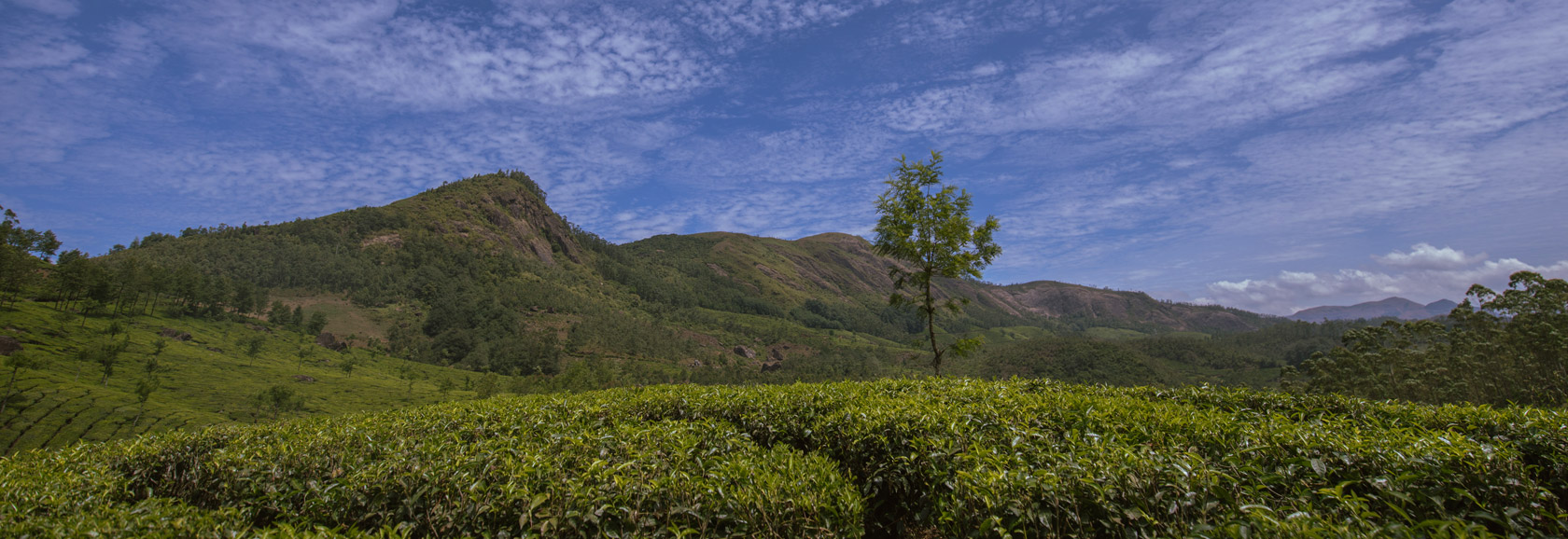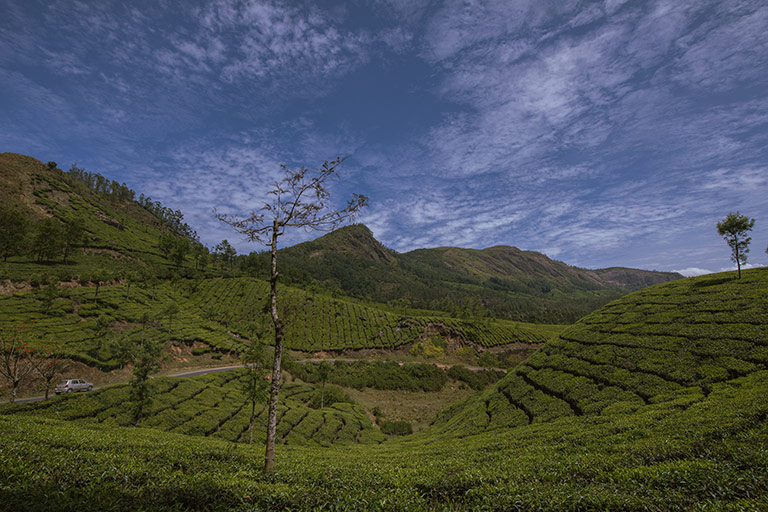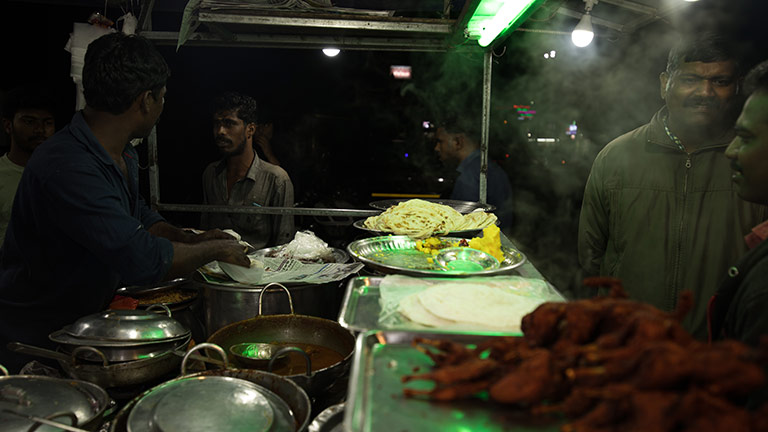

Blessings in Blue – A Rendezvous with the Neelakurinji
Espero, a glimpse into the world of an incurable romantic
-Pooja Sarath Chandran


Espero, a glimpse into the world of an incurable romantic
-Pooja Sarath Chandran


The next morning after an early breakfast at the hotel we headed out to explore the Letchmi Route the locals were all raving about.
Given the beauty and immense popularity of the place, we were pleasantly surprised at how devoid of traffic it was.
Serene and nicely tucked away from the hustle bustle of Munnar Town, this route is a must visit area if you are the kind that enjoys long drives with the wind in your hair.

Letchmi Estate is where it takes you and my! Was it beautiful or what!
The long winding roads weaving through lush green tea plantations… There were small shrines at regular intervals almost as if they were the guardians of the land. The Shola forests surround the area on all sides and save the portions taken up by tea plantations, the area was the home turf of wild elephants. Sightings of herds of elephants on this route are so common that even we, who were not looking to find them, actually got lucky.
Here’s what happened.
As we drove along enjoying the climate and the scenery we reached a spot where there were cattle grazing and in the distance, against the backdrop of the forest was a small school.
We stopped the car and were just about to step out when a tall thin man in a shabby shirt and shorts, wielding a long stick shouted out to us in Tamil. He was a cowherd and was tending to his cattle.
“Oye! What are you doing? Two elephants with a calf just crossed over to drink water. They may return any minute now. Besides, there is a herd waiting to cross over from there.” he said, pointing to the jungle to our left.
I turned to stare at the thick blanket of greenery with a new found sense of awe. In my head I could already see a herd of tall majestic wild Indian Elephants gazing back at me from the undergrowth.
“Okay, could we just take a few snaps of the school and then leave?” asked Hubby.
“Leave?! Who wants to leave? I wanna see the elephants!” I retorted in my head.
“Do as you please.” The cowherd shrugged and turned away.
I watched him walk off towards the school twirling his stick and shouting incomprehensible instructions to the cows. He seemed like an extension of the forests around us. A person who conversed with Nature and understood its nuances like none of us ever can. Hubby pointed out that he was herding his cows away from the area in which he believed the elephants were.
After taking a few pictures we decided to drive down to the school and try working up a conversation with the cowherd to see if there was a way for us to see the pachyderms.
In a few minutes we were standing in the yard of the tiny school surrounded by the few teachers there and the cowherd, who we now learnt, belonged to the Muthuva tribe indigenous to these parts.
“There’s a calf with them and so it’s a little dangerous if they get irked. They will steer clear of trouble as far as possible but if they feel threatened… they are wild animals so…” one of the teachers, a young lady explained.
Elephants were a part of their daily life. With a jungle stream flowing right in front of their school, wild animals dropping by for a drink was a regular sight.
“There! They're coming this way!”
The shout of the tribesman who had walked away to survey the scene rushed all of us to where he was standing pointing at the thick undergrowth.
Within moments we could hear the cracking of branches and see the tops of young trees shaking as the trio made their way through the forest bordering the school.
And there they were!
Alerted by our presence they had decided to go deeper into the wilderness but not before offering us a glimpse of their raw beauty. Each of them, including the calf, paused to turn and toss us a glance before heading their way, leaving us disappointed yet happy with our little adventure.
“They come out onto the road every evening to get away from the mosquitoes in the jungle. If you wait till then you can see herds of 6-7 elephants on this route.” said Mr. Selvam, one of the locals gathered there.
I chuckled thinking he was joking about the mosquito bit but when I looked around I realised that nobody else was.
The chatter slowly drifted away from elephants to the local life and tea plantations.
Ever since we started seeing the tea plantations of Munnar a doubt that had been niggling me was the difference in their appearance. While the bushes in some areas were set in neat rows, others had them in patches.
Mr. Selvam explained to me that those areas that had the bushes in rows were planted to enable the easy use of machines for plucking. These plants were barely 12 years old. With the areas that were in patches the story was different.
The bushes were over 120 years old and had the third generation of plantation workers working on them.
Yup. You heard that right.
120 years.
Whew!
I turned around and stared at the distant hill sides with a gasp frozen on my lips. Who would’ve thought that?!
I felt so small. Humbled!
Just as I was reeling from that revelation he smiled and drew my attention from the tea plants to the tall slender trees that stood amidst them at regular intervals.
“You see those trees? Their relationship with the tea plants is like a tragic friendship.”
“Really?” Hubby is all ears.
“Those are Silver Oak trees. Ever since the British introduced tea as a plantation crop here in the 19th century, they had been in search of the ideal companion shade tree as the success of the tea cultivation depends on an optimum degree of soil moisture and annual rainfall. The Silver Oaks were the best bet as they did not compete for moisture and nutrients with the tea plants. They were ideal friends as they served as wind breakers and their roots run deep unlike those of the plants. The sad part is, after five years when the yields start and the shade is no longer needed the trees are axed.” he said.
As we bade goodbye to our new found friends and headed back to our car we were overwhelmed by all that we had heard and seen. The tea plantations and jungles around us took on emotions and sentient characteristics we never imagined they had.
We realised with pain that the plantations, as beautiful as they are, are actually a remnant of colonisation by the British. In fact these plantations have colonised the natural ecosystem of these parts disturbing its delicate balance.
It is the rampant and widespread clearing of the forests to make way for the plantations that has led to the endangering of the Neelakurinji we are in search of.

After a quick lunch we headed to Mattupetty which is renowned for its storage masonary dam and the beautiful lake where we planned to spend a few hours. Located about 1700m above sea level, Mattupetty is also famous for the dairy farm there run by the Indo Swiss Livestock Project.
We were looking for a place to sit down, breathe and let Minnu wander around a bit to stretch her limbs. So we headed away from the crowds at the boating area to a spot that offered soothing scenery and an extremely rejuvenating breeze. It was the last pit stop as we were going to Rajamala to see for ourselves the Neelakurinji the next day.
The lake bordered by the Sholas is an ideal spot to tune away from the pandemonium around and just be.
Let the breeze serenade your heart with its tunes for a little while and you will realise how much you need that kinda break from the world. A break from routines, timetables, people and the mundane details of daily life.
As I sat there gazing at the mountains in the distance with my baby beside me I couldn’t help but wonder what the Neelakurinji (Strobilanthes kunthianum) waits 12 years to tell us, each time it blossoms.
They say the plant dies soon after it blooms and that it takes 10 months for the seeds to sprout. Just imagine a small little seed taking 10 laborious months to sprout and then another 12 years to bloom just to die soon after.
Maybe, just maybe, it is trying to tell us something.
“Happy?” Hubby’s voice broke into my musings.
I smiled. The three of us sat together quietly gazing at the mountains, forests and the calm, serene lake, all painting a scene of gentle, caressing beauty.
After a beautiful evening spent in the embrace of Nature we headed back to Munnar Town and the cosiness of our room to freshen up and relax.
By around 7.30pm we were back on the road to get a feel of the night life there. We chose to drive down to town and then walk around as our hotel was in Old Munnar and it was a bit of a walk to get to the centre of activity in town.
The chill in the air, wisps of mist and the sound of crickets crooning united to create the perfect setting.
As we sauntered along through the Main Bazaar and streets relishing the sights and the freshness of the night air we came upon an island of frenzied activity.

It was a Thattukada (local makeshift eatery) and the smells that wafted over to us made our tummies rumble.
The Thattukada essentially comprised an open cart that served as the kitchen, a separate area for getting the dough of the Porottas ready and yet another square bit of space for a huge hot griddle on which Dosas were being cooked.
In that soothing cold air it was incredible just how many different aromas were squabbling for our attention.
The sound of the Porotta dough being slapped onto the oiled metal table, Kothuporotta being chopped up, hot oil spluttering and sizzling as beaten egg and onions are poured into it for omelets, Dosa batter hissing in protest as it is spread out onto the hot tawa, orders being shouted out, the clamour of plates and dishes, customers seated in a makeshift tent all chitchatting as they relished the food… In every sense the Thattukada offered a symphony in itself. It was such a vibrant spread!
After a sumptuous dinner of piping hot Kothuporotta, Dosas and Kappa (Tapioca) with fried chicken and omelets we retired eager to get started on our big adventure the next day.
“Hey, guess what?” Sarath saunters i ...more
Kumarakom, a part of the Kuttanadu region, is a pl ...more
One of the best features about Kumarakom is its cl ...more
The next morning was spent exploring spice gar ...more
The next morning after an early breakfast at t ...more
We woke up pretty early the next morning. Our exci ...more
Munnar offers both busy spots and seclude ...more